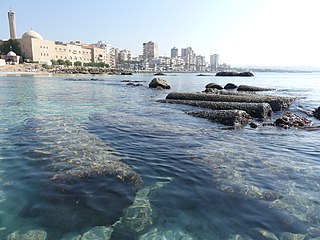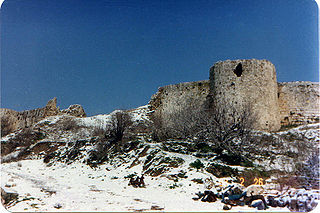
Sidon, known locally as Sayda or Saida, is the third-largest city in Lebanon. It is located in the South Governorate, of which it is the capital, on the Mediterranean coast. Tyre to the south and Lebanese capital Beirut to the north are both about 40 kilometres away. Sidon has a population of about 80,000 within city limits, while its metropolitan area has more than a quarter-million inhabitants.

Tyre is a city in Lebanon, one of the oldest continually inhabited cities in the world, though in medieval times for some centuries by just a tiny population. It was one of the earliest Phoenician metropolises and the legendary birthplace of Europa, her brothers Cadmus and Phoenix, as well as Carthage's founder Dido (Elissa). The city has many ancient sites, including the Tyre Hippodrome, and was added as a whole to UNESCO's list of World Heritage Sites in 1984. The historian Ernest Renan noted that "One can call Tyre a city of ruins, built out of ruins".
Hiram I was the Phoenician king of Tyre according to the Hebrew Bible. His regnal years have been calculated by some as 980 to 947 BC, in succession to his father, Abibaal. Hiram was succeeded as king of Tyre by his son Baal-Eser I. Hiram is also mentioned in the writings of Menander of Ephesus, as preserved in Josephus's Against Apion, which adds to the biblical account. According to Josephus, Hiram lived for 53 years and reigned 34.
The King of Tyre was the ruler of Tyre, the ancient Phoenician city in what is now Lebanon.
The nine governorates of Lebanon are subdivided into 25 districts. Beirut Governorate is not subdivided into districts, and Akkar Governorate comprises a single district.

South Governorate is one of the governorates of Lebanon. South Lebanon has a population of 500,000 inhabitants and an area of 929.6 km². The capital is Sidon. The lowest elevation is sea-level; the highest is 1,000 meters. The local population is religiously diverse and includes Shia and Sunni Muslims, Druze, Eastern Orthodox, Maronite, Protestant, and Greek Catholic Christians. Temperatures can drop to 4 °C during winter with much rain and snow on the higher ground. In the humid summer, temperatures can rise to 30 °C in the coastal areas. The governorate has several rivers: the Litani, Deir El Zahrani, Naqoura, Awali, Qasmiye, and Hasbani. The area is famous for its citrus and banana farms. Its main cities are Sidon, Tyre and Jezzine.
Southern Lebanon is the area of Lebanon comprising the South Governorate and the Nabatiye Governorate. The two entities were divided from the same province in the early 1990s. The Rashaya and Western Beqaa Districts, the southernmost districts of the Beqaa Governorate, in Southern Lebanon are sometimes included.

Tadamon Sour Sporting Club, or simply Tadamon, is a football club based in Tyre, Lebanon, that competes in the Lebanese Premier League. They play their home matches at the Tyre Municipal Stadium, and have won one Lebanese FA Cup and two Lebanese Challenge Cups.

The Rashidieh camp is the second most populous Palestinian refugee camp in Lebanon, located on the Mediterranean coast about five kilometres south of the city of Tyre (Sur).

The Tyre District is a district in the South Governorate of Lebanon.
The Persian Empire, including modern Lebanon, eventually fell to Alexander the Great, king of Macedonia. He attacked Asia Minor, defeated the Persian troops in 333 BC, and advanced toward the Lebanese coast. Initially the Phoenician cities made no attempt to resist, and they recognized his suzerainty. However, when Alexander tried to offer a sacrifice to Melqart, Tyre's god, the city resisted. Alexander besieged Tyre in retaliation in early 332 BC. After seven months of resistance, the city fell, and its people were sold into slavery. Despite his early death in 323 BC, Alexander's conquest of the eastern Mediterranean Basin left a Greek imprint on the area. The Phoenicians, being a cosmopolitan people amenable to outside influences, adopted aspects of Greek civilization with ease.
The Tyre headquarters bombings were two suicide bombings against the Israel Defense Forces' headquarters building in Tyre, Lebanon, in 1982 and 1983. The blasts killed 103 Israelis and 46–59 Lebanese, wounding 95 people and were some of the worst losses ever for the IDF. The second attack occurred in November 1983 and was attributed to Hezbollah.

The Al-Bass Tyre necropolis is a Lebanese UNESCO World Heritage site in the city of Tyre situated next to the el-Buss refugee camp. The necropolis, constituting the principal entrance of the town in antique times, is to be found on either side of a wide Roman and Byzantine avenue dominated by a triumphal arch of the 2nd century. Other important monumental vestiges of this archaeological area are an aqueduct, which carried water to the city, and a 2nd-century hippodrome.

Burj el-Shemali is a municipality located some 86 km south of Beirut and 3 km east of the Tyre/Sour peninsula, merging into its urban area. It is part of the Tyre Union of Municipalities within the Tyre District of the South Governorate of Lebanon.
The 2011–12 Lebanese Premier League was the 51st season of top-tier football in Lebanon. A total of twelve teams competed in the league, with Al Ahed the defending champions.

Phoenicia was an ancient thalassocratic civilization originating in the Levant region of the eastern Mediterranean, primarily located in modern Lebanon. It was concentrated along the coast of Lebanon and included some coastal areas of modern Syria and Galilee, reaching as far north as Arwad, and as far south as Acre and possibly Gaza. At its height between 1100 and 200 BC, Phoenician civilization spanned the Mediterranean from Cyprus to the Iberian Peninsula.

El-Buss camp – also transliterated Bass, Bas, or Baas with either the article Al or El respectively – is one of the twelve Palestinian refugee camps in Lebanon, located in the Southern Lebanese city of Tyre. It had been a refuge for survivors of the Armenian genocide from the 1930s until the 1950s, built in a swamp area which during ancient times had for at least one and a half millennia been a necropolis. In recent decades it has been "at the center of Tyre’s experience with precarity" and "a space that feels permanent yet unfinished, suspended in time."
Kniseh is a Syrian village located in Muhambal Nahiyah in Ariha District, Idlib. According to the Syria Central Bureau of Statistics (CBS), Kniseh had a population of 2373 in the 2004 census.

El-Assaad or Al As'ad is a feudal political family/clan originally from Najd and a main branch of the anza tribe. Unrelated to Syrian or Palestinian Al-Assads, El-Assaad dynasty that ruled most of South Lebanon for three centuries and whose lineage defended fellow denizens of history’s Jabal Amel principality – today southern Lebanon – for 36 generations, Balqa in Jordan, Nablus in Palestine, and Homs in Syria governed by Ottoman rule between generations throughout the Arab caliphate by Sheikh al Mashayekh Nasif Al-Nassar ibn Al-Waeli, Ottoman conquest under Shbib Pasha El Assaad, Ali Bek El Assaad ruler of Belad Bechara, Ali Nassrat Bek. Advisor of the Court and a Superior in the Ministry of Foreign affairs in the Ottoman Empire, Moustafa Nassar Bek El Assaad Supreme Court President of Lebanon and colonial French administration by Hassib Bek—also supreme court Judge and grand speaker at halls across the Levant. El-Assaads are considered now "Bakaweit", and are considered princes or heirs to the family's dynasty to some.












